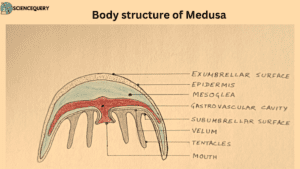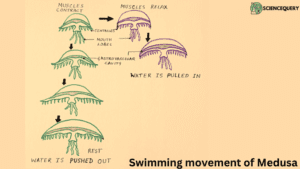
Introduction
Cnidarians inhibit all regions of the world’s ocean and some freshwater environments. They are an integral part of the marine ecosystem. The habitats of cnidarians vary greatly on whether they take on predominantly polyp body forms or medusa body forms. In this topic, we will know in detail about polyp vs medusa forms.
About Polyp
All cnidarian forms can exist either in a solitary form or in a colony. The colonial form shows polymorphism i.e., the occurrence of more than one type of individuals in the same species which differ in form and function. The two main types of individuals are polyp and medusa.
Morphology and body structure
- Diploblastic, tubular, fixed at the base by aboral end through a pedal disc which acts as a holdfast.
- The mouth is at the oral end surrounded by tentacles, gastrovascular cavity is simple.
- Sense organs and gonads are absent.
- Connected with feeding, protection, and asexual reproduction.
- Modified polyps are of two types :
- Gastrozooids – feeding polyps with mouth and tentacle
- Gonozooids – Reproductive polyps that bud to produce sexual medusa.

Mode of locomotion
- The polyps are sessile(fixed to the substratum). However, they exhibit certain swaying movements under the force of water currents due to the presence of flexible ring-like structures called annuli on the outer surface of the exoskeleton.
- Some species like Hydra which exist in polyp form can also move from place to place by looping and somersaulting, floating and gliding.
Reproduction
- Asexual methods involve two processes
- Budding
- Fission.
Budding: The polyps bud off from the side creating a new polyp.
Fission: Polyps split into halves through the tentacles creating the new polyps.
- Other than this new colonies can form by fragmentation too. Broken pieces of a colony can fall off and reattach themselves to the substrate.
- Sexual methods include
- Broadcasting
- Brooding techniques
Broadcasting: Done by releasing gametes (sperm and egg) which fuse to fertilize and subsequently form microscopic planula larva.
Brooding: Sperms are released in the water which sinks on the eggs lying underneath leading to fertilization, followed by the development of planula larva.
Examples of some well-known polyps

Hydra, Corals, Sea anemones
About Medusa
Medusa represents the sexual generation, a solitary and free-swimming animal.
Morphology and body structure of medusa
Umbrella shaped
- Dorsal convex exumbrellar surface.
- Ventral concave sub-umbrella surface.
- Tetramerous radial symmetry, with the mouth(hypostome) at the center of the ventral side and tentacles, are present around the mouth and also along the margin of the medusa.
- The mouth leads upward into the gastrovascular cavity.
- The margins of the medusa bear initially 16 short contractile tentacles which gradually increase in number.
- A gastrovascular cavity is complex, with statocysts (organs of balance) present.

Mode of locomotion

- Medusa swims in water by jet propulsion method.
- The alternate contraction and expansion of the bell muscles alternatively close and open the bell which forces water out of the subumbrellar cavity downwards and propels the body in an upward direction.
- Medusa also floats passively in seawater under the force of strong water currents and wind.
Reproduction
- Medusa possesses four gonads on the subumbrellar surface.
- They are dioecious, male and female medusa being separate or hermaphrodite.
- The medusa produces sperm and ova and releases them into the water where fertilization takes place.
- Sometimes sperm enter the female medusa along with the water current and fertilization takes place inside the body of the female medusa.

Examples of some well-known medusa
Portuguese man of war, Moon jelly, Box jelly
Polyp Vs Medusa
S/N |
Polyp |
Medusa |
| 1. | Polyp is sessile form. | The medusa is the free-from or swimming form. |
| 2. | The body is cylindrical and tubular with the mouth facing upwards. | Here the body is umbrella-shaped, mouth faces downward. |
| 3. | Attached to the rock. | Found in open water. |
| 4. | Lacks sense organs. | Statocysts are present. |
| 5. | Gastrovascular cavity is simple. | Gastrovascular cavity has four radial canals and one circular canal. |
| 6. | Gonads are absent. | Gonads are present. |
| 7. | Velum is absent. | Velum is present. |
| 8. | Modified polyps are
|
Modified medusa are
|
| 9. | Polyps have a long life span. | Medusa is short-lived. |
Ecological significance of Polyp and Medusa
- Coral reefs: Member of class Anthozoa exist only in polyp form, and serve as a huge source of food and shelter to many algae, fish, and other invertebrate animals.
- Polyps through their filter feeding method ( feeding by straining suspended matter and food particles from the water and passing it through a specialized filtering structure) clean he surrounding water and helps the other organisms too, increasing ecosystem health.
- It helps to prevent the erosion of the shoreline.
- Medusa swarms as in jellyfish compete with other organisms in the ecosystem for food and can cause problems in the food chain.
Q&A
1. How is the polyp phase different from the medusa phase?
Polyp is a sessile, asexual phase of the cnidarians whereas medusa is the free-swimming sexual phase.
2. Does a polyp become a medusa?
Yes, through budding the polyp can give rise to medusa.
3. What is the difference between polyp and medusa what type of symmetry?
Polyps have biradial symmetry whereas medusa have tetramerous, radial symmetry.
4. What is the difference between a sessile polyp and motile medusa?
Sessile polyps can be solitary or colonial whereas motile medusa is always solitary.
Summary
- Polyp vs Medusa both are cnidaria. The former ones are sessile and the latter are free-floating.
- Cnidarians are aquatic, mostly marine, some freshwater, and diploblastic.
- Solitary forms or colonial, sedentary, or free swimming, possess stinging cells cnidoblasts.
- Colonial forms show polymorphism ( occurrence of more than one type of individuals in the same species differing in form and function)- polyp and medusa.
- Polyps are sessile, colonial, or solitary and have tubular bodies, one end is attached to the substratum by the pedal disc and the mouth is at the opposite end surrounded by tentacles.
- Concerned with asexual reproduction.
- The medusa is umbrella-shaped with marginal tentacles, free swimming through jet propulsion method, solitary, mouth hanging down into the water.
- They are concerned with sexual reproduction only.
CONCLUSION – Cnidarians are more advanced than the Poriferans but show considerable evolutionary unique features that separate them from phylum Ctenophora.
References
1. The invertebrates – Protozoa through Ctenophora – Publisher Tata Mc Graw Hills.
2. Biology of Animals (Volume 1 and II)
